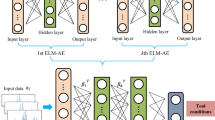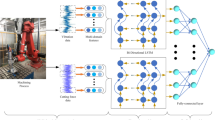Abstract
This paper proposes the ball mill load recognition algorithm (MRUF-WD) based on multi-residual unit fusion (MRUF) and Wasserstein distance transfer learning to address the problem of accurately judging the working state parameters during ball mill grinding operations. The proposed algorithm can significantly enhance the processing capability of under-labeled or unlabeled data, while ensuring excellent transfer capability even when there is a large data gap between the target and source domains. The MRUF-WD transfer algorithm first inputs collected ball mill vibration data under different working conditions into the MRUF feature extraction network based on ResNet-18, where MRUF can extract feature information from the upper, middle, and lower layers of the network for learning. This approach equips the algorithm with enhanced feature extraction capability, leading to a significant improvement in the processing capability for under-labeled or unlabeled data. This algorithm has a better ability to deal with under-labeled or unlabeled data through its improved feature extraction capability. It then inputs a classifier that uses Wasserstein distance as a loss function to measure distance between source and target domain data, as well as a domain alignment network. The Wasserstein distance loss function, also known as EDM (Earth Mover’s Distance), measures the distance between two probability distributions and exhibits broader applicability, better robustness, and improved continuity when the probability distribution of the data changes, compared to other common distance metrics. After the parameters are updated by back propagation, the algorithm uses the invariant features learned in the source domain to identify the load in the target domain.







Similar content being viewed by others
Data availability
The experimental data in Sect. 4.1 were obtained in the laboratory of Jiangxi University of Science and Technology.
References
Luo, X., Huang, Y., Li, B., Liu, J.: Development of PSO-LSSVM-based ball mill load parameter prediction and monitoring system. Noise Vib. Control 42(4), 144–151 (2022)
Liu, Z., Tang, J., Chai, T., Yu, W.: A mill load parameter prediction method based on selective integrated modeling of multimodal feature subsets. J. Autom. 47(8), 1921–1931 (2021)
Tang, J., Qiao, J., Liu, Z., Zhou, X., Yu, G., Zhao, J.: Multi-channel mechanical signal analysis evaluation and optimal combination for mill load parameter prediction. J. Beijing Inst. Technol. 46(9), 997–1007 (2020)
Sui, L.: Research on soft measurement modeling of key parameters of wet ball mill based on multi-task and transfer learning. Taiyuan University of Technology (2018)
Tang, J., Qiao, J.F., Liu, Z., Zhou, X.J., Yu, G., Zhao, J.J.: Mechanism characteristic analysis and soft measuring method review for ball mill load based on mechanical vibration and acoustic signals in the grinding process (Review). Miner. Eng. 28(1), 294–311 (2018)
Wang, X., Sun, K., Zhang, H., Xiong, W., Yang, C.: Mill load identification method for ball milling process based on grinding signal. IFAC-PapersOnLine 54(21), 7–12 (2021)
Yang, D., Karimi, H.R., Pawelczyk, M.: A new intelligent fault diagnosis framework for rotating machinery based on deep transfer reinforcement learning. Control. Eng. Pract. 134, 105475 (2023)
Huang, M., Yin, J., Yan, S., et al.: A fault diagnosis method of bearings based on deep transfer learning. Simul. Model. Pract. Theory 122, 102659 (2023)
Liu, G., Shen, W., Gao, L., et al.: Automated broad transfer learning for cross-domain fault diagnosis. J. Manuf. Syst. 66, 27–41 (2023)
He, K.M., Zhang, X.Y., Ren, S.Q., Sun, J.: Deep residual learning for image recognition. In: 2016 IEEE Conference on Computer Vision and Pattern Recognition (CVPR), pp. 770–778 (2016)
Wang, R., An, S., Liu, W., Li, L.: Invertible residual blocks in deep learning networks. IEEE Trans. Neural Netw. Learn. Syst. 1–7 (2023)
Arjovsky, M., Chintala, S., Bottou, L.: Wasserstein gan. arXiv:1701.07875 (2017)
Long, M., Cao, Y., Wang, J., Jordan, M.I.: Learning transferable features with deep adaptation networks. In: Computer Science (2015)
Gretton, A., Borgwardt, K.M., Rasch, M.J., Scholkopf, B., Smola, A.: A kernel two-sample test. J. Mach. Learn. Res. 13, 723–773 (2012)
Xu, K., Li, S., Jiang, X., An, Z., Wang, J., Yu, T.: A renewable fusion fault diagnosis network for the variable speed conditions under unbalanced samples. Neurocomputing 379, 12–29 (2020)
Goodfellow, I., Pouget-Abadie, J., Mirza, M., Bing, X., Warde-Farley, D., Ozair, S., Courville, A., Bengio, Y.: Generative adversarial networks. Commun. ACM 63(11), 139–144 (2020)
Ganin, Y., Ustinova, E., Ajakan, H.: Domain-adversarial training of neural networks. J. Mach. Learn. Res. 17(1), 2096 (2016)
Funding
The National Natural Science Foundation of China (NSFC) project “Research on energy consumption of vibratory crushing based on multi-scale cohesive particle model” [Grant No. 51464017] and the Science and Technology Project of Jiangxi Provincial Department of Education, “State monitoring and load intelligent identification of wolframite milling process” [Grant No. 200827] provided partial support for this study.
Author information
Authors and Affiliations
Contributions
Xu wrote the main manuscript text and Xiao prepared figures 2, 3, 6. Luo provided deep learning model guidance and experimental equipment. All authors reviewed the manuscript.
Corresponding author
Ethics declarations
Competing interests
The authors declare no competing interests.
Ethical approval
This study did not involve human or animal subjects, and thus, no ethical approval was required. The study protocol adhered to the guidelines established by the journal.
Additional information
Publisher’s Note
Springer Nature remains neutral with regard to jurisdictional claims in published maps and institutional affiliations.
Rights and permissions
Springer Nature or its licensor (e.g. a society or other partner) holds exclusive rights to this article under a publishing agreement with the author(s) or other rightsholder(s); author self-archiving of the accepted manuscript version of this article is solely governed by the terms of such publishing agreement and applicable law.
About this article
Cite this article
Xu, H., Luo, X. & Xiao, W. Multi-residual unit fusion and Wasserstein distance-based deep transfer learning for mill load recognition. SIViP 18, 3187–3196 (2024). https://doi.org/10.1007/s11760-023-02981-6
Received:
Revised:
Accepted:
Published:
Issue Date:
DOI: https://doi.org/10.1007/s11760-023-02981-6




